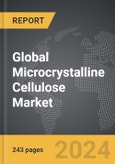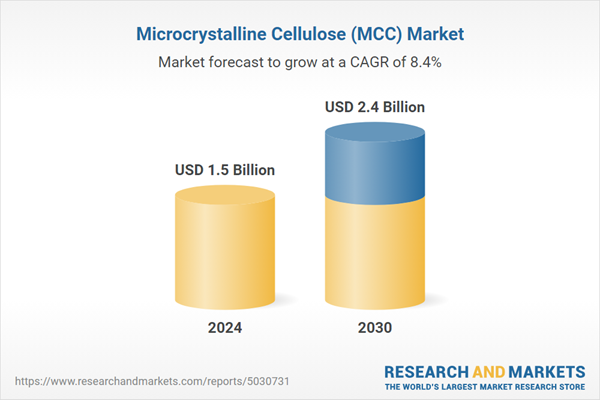The global market for Microcrystalline Cellulose (MCC) was valued at US$1.5 Billion in 2024 and is projected to reach US$2.4 Billion by 2030, growing at a CAGR of 8.4% from 2024 to 2030. This comprehensive report provides an in-depth analysis of market trends, drivers, and forecasts, helping you make informed business decisions. The report includes the most recent global tariff developments and how they impact the Microcrystalline Cellulose (MCC) market.
Segments: Source (Wood, Non-Wood); Application (Pharmaceutical, Food & Beverage, Cosmetics & Personal Care, Other Applications).
Geographic Regions/Countries: World; USA; Canada; Japan; China; Europe; France; Germany; Italy; UK; Spain; Russia; Rest of Europe; Asia-Pacific; Australia; India; South Korea; Rest of Asia-Pacific; Latin America; Argentina; Brazil; Mexico; Rest of Latin America; Middle East; Iran; Israel; Saudi Arabia; UAE; Rest of Middle East; Africa.
The analysts continuously track trade developments worldwide, drawing insights from leading global economists and over 200 industry and policy institutions, including think tanks, trade organizations, and national economic advisory bodies. This intelligence is integrated into forecasting models to provide timely, data-driven analysis of emerging risks and opportunities.
Global Microcrystalline Cellulose (MCC) Market - Key Trends & Drivers Summarized
What Is Microcrystalline Cellulose and Why Is It Significant?
Microcrystalline cellulose (MCC) is a refined wood pulp derivative widely recognized for its excellent properties as an excipient in pharmaceutical applications. It is inert, non-allergenic, and has excellent compressibility properties, making it an ideal binder, filler, and disintegrant in tablet formulations. MCC is chemically inert and can be used in both wet granulation and direct compression processes, a versatility that extends its utility in the pharmaceutical sector. Beyond this primary industry, MCC is increasingly used in food production as a texturizer, anti-caking agent, fat substitute, and emulsifier, enhancing the texture and consistency of products like ice cream, whipped cream, and bakery items.How Is MCC Produced and What Are Its Key Properties?
MCC is manufactured through the controlled hydrolysis of cellulose by acid. This process removes the amorphous regions of the cellulose chain, leaving behind the crystalline segments. The result is a white, odorless, tasteless powder that is insoluble in water, dilute acids, and most organic solvents but has high adsorption capacity. Its physical properties include high compressibility and excellent binding capability, which prevent the disintegration of tablets. MCC's versatility is not limited to its chemical properties; it also excels in thermal stability and low reactivity, making it a dependable choice in complex pharmaceutical formulations and processed food products.What Trends Are Influencing the Use of MCC in Various Industries?
The demand for MCC is closely linked to trends in the pharmaceutical and food industries. In pharmaceuticals, the shift towards more sophisticated drug delivery mechanisms and the continuous development of generic drugs are key drivers. MCC is favored in the design of solid dosage forms for its role in improving the release and bioavailability of drugs. In the food industry, the rising consumer demand for low-fat and low-calorie products that do not compromise on texture or taste boosts the use of MCC as a fat replacer and texturizer. Additionally, the clean-label trend, which favors ingredients perceived as natural, has positioned MCC as a desirable option over synthetic additives.What Drives the Growth in the Microcrystalline Cellulose Market?
The growth in the MCC market is driven by several factors, including advances in pharmaceutical and food production technologies, growing health consciousness among consumers, and stringent regulations regarding the quality and safety of pharmaceutical excipients and food additives. Technological innovations in tablet manufacturing have heightened the demand for superior excipients like MCC that offer enhanced functionality and compliance with regulatory standards. Furthermore, the global expansion of the pharmaceutical industry, particularly in developing countries, stimulates the demand for MCC, as it is crucial in manufacturing a wide array of medications. Additionally, consumer behavior that leans towards healthier and safer food products continues to influence the food processing industry's reliance on MCC.Report Scope
The report analyzes the Microcrystalline Cellulose (MCC) market, presented in terms of units. The analysis covers the key segments and geographic regions outlined below.Segments: Source (Wood, Non-Wood); Application (Pharmaceutical, Food & Beverage, Cosmetics & Personal Care, Other Applications).
Geographic Regions/Countries: World; USA; Canada; Japan; China; Europe; France; Germany; Italy; UK; Spain; Russia; Rest of Europe; Asia-Pacific; Australia; India; South Korea; Rest of Asia-Pacific; Latin America; Argentina; Brazil; Mexico; Rest of Latin America; Middle East; Iran; Israel; Saudi Arabia; UAE; Rest of Middle East; Africa.
Key Insights:
- Market Growth: Understand the significant growth trajectory of the Pharmaceutical segment, which is expected to reach US$1.0 Billion by 2030 with a CAGR of a 9.1%. The Food & Beverage segment is also set to grow at 8.5% CAGR over the analysis period.
- Regional Analysis: Gain insights into the U.S. market, valued at $335.5 Million in 2024, and China, forecasted to grow at an impressive 11.0% CAGR to reach $346.5 Million by 2030. Discover growth trends in other key regions, including Japan, Canada, Germany, and the Asia-Pacific.
Why You Should Buy This Report:
- Detailed Market Analysis: Access a thorough analysis of the Global Microcrystalline Cellulose (MCC) Market, covering all major geographic regions and market segments.
- Competitive Insights: Get an overview of the competitive landscape, including the market presence of major players across different geographies.
- Future Trends and Drivers: Understand the key trends and drivers shaping the future of the Global Microcrystalline Cellulose (MCC) Market.
- Actionable Insights: Benefit from actionable insights that can help you identify new revenue opportunities and make strategic business decisions.
Key Questions Answered:
- How is the Global Microcrystalline Cellulose (MCC) Market expected to evolve by 2030?
- What are the main drivers and restraints affecting the market?
- Which market segments will grow the most over the forecast period?
- How will market shares for different regions and segments change by 2030?
- Who are the leading players in the market, and what are their prospects?
Report Features:
- Comprehensive Market Data: Independent analysis of annual sales and market forecasts in US$ Million from 2024 to 2030.
- In-Depth Regional Analysis: Detailed insights into key markets, including the U.S., China, Japan, Canada, Europe, Asia-Pacific, Latin America, Middle East, and Africa.
- Company Profiles: Coverage of players such as DuPont de Nemours, Inc., Asahi Kasei Corporation, FMC Corporation, Avantor, Inc., Roquette FrAres and more.
- Complimentary Updates: Receive free report updates for one year to keep you informed of the latest market developments.
Some of the 39 companies featured in this Microcrystalline Cellulose (MCC) market report include:
- DuPont de Nemours, Inc.
- Asahi Kasei Corporation
- FMC Corporation
- Avantor, Inc.
- Roquette FrAres
- Foodchem International Corporation
- DFE Pharma GmbH & Co. KG
- Sidley Chemical Co., Ltd.
- Maple Biotech Pvt., Ltd.
- Godavari Biorefineries Ltd.
- Hefei TNJ Chemical Industry Co., Ltd.
- Green Agrochem
- Chemfield Cellulose Pvt. Ltd.
- NutraCap Labs
Tariff Impact Analysis: Key Insights for 2025
Global tariff negotiations across 180+ countries are reshaping supply chains, costs, and competitiveness. This report reflects the latest developments as of April 2025 and incorporates forward-looking insights into the market outlook.The analysts continuously track trade developments worldwide, drawing insights from leading global economists and over 200 industry and policy institutions, including think tanks, trade organizations, and national economic advisory bodies. This intelligence is integrated into forecasting models to provide timely, data-driven analysis of emerging risks and opportunities.
What’s Included in This Edition:
- Tariff-adjusted market forecasts by region and segment
- Analysis of cost and supply chain implications by sourcing and trade exposure
- Strategic insights into geographic shifts
Buyers receive a free July 2025 update with:
- Finalized tariff impacts and new trade agreement effects
- Updated projections reflecting global sourcing and cost shifts
- Expanded country-specific coverage across the industry
Table of Contents
I. METHODOLOGYII. EXECUTIVE SUMMARY2. FOCUS ON SELECT PLAYERSIII. MARKET ANALYSISIV. COMPETITION
1. MARKET OVERVIEW
3. MARKET TRENDS & DRIVERS
4. GLOBAL MARKET PERSPECTIVE
UNITED STATES
CANADA
JAPAN
CHINA
EUROPE
FRANCE
GERMANY
ITALY
UNITED KINGDOM
SPAIN
RUSSIA
REST OF EUROPE
ASIA-PACIFIC
LATIN AMERICA
MIDDLE EAST
AFRICA
Companies Mentioned (Partial List)
A selection of companies mentioned in this report includes, but is not limited to:
- DuPont de Nemours, Inc.
- Asahi Kasei Corporation
- FMC Corporation
- Avantor, Inc.
- Roquette FrAres
- Foodchem International Corporation
- DFE Pharma GmbH & Co. KG
- Sidley Chemical Co., Ltd.
- Maple Biotech Pvt., Ltd.
- Godavari Biorefineries Ltd.
- Hefei TNJ Chemical Industry Co., Ltd.
- Green Agrochem
- Chemfield Cellulose Pvt. Ltd.
- NutraCap Labs
Table Information
| Report Attribute | Details |
|---|---|
| No. of Pages | 243 |
| Published | April 2025 |
| Forecast Period | 2024 - 2030 |
| Estimated Market Value ( USD | $ 1.5 Billion |
| Forecasted Market Value ( USD | $ 2.4 Billion |
| Compound Annual Growth Rate | 8.4% |
| Regions Covered | Global |









